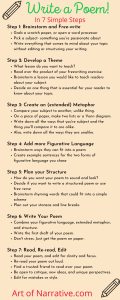

Learn how to write a poem through seven easy to follow steps that will guide you through writing completed poem. Ignite a passion for poetry!
This article is a practical guide for writing a poem, and the purpose is to help you write a poem! By completing the seven steps below, you will create the first draft of a simple poem. You can go on to refine your poetry in any way you like. The important thing is that you’ve got a poem under your belt.
At the bottom of the post, I’ll provide more resources on writing poetry. I encourage you to explore different forms and structures and continue writing poetry on your own. Hopefully, writing a poem will spark, in you, a passion for creative writing and language.
Let’s get started with writing a poem in seven simple steps:
Now we’ll go into each step in-depth. And, if your feeling up to it, you can plan and write your poem as we go.

Before you begin writing, you need to choose a subject to write about. For our purposes, you’ll want to select a specific topic. Later, you’ll be drawing a comparison between this subject and something else.
When choosing a subject, you’ll want to write about something you feel passionately about. Your topic can be something you love, like a person, place, or thing. A subject can also be something you struggle with. Don’t get bogged down by all the options; pick something. Poets have written about topics like:
Once you have your subject in mind, you’re going to begin freewriting about that subject. Let’s say you picked your pet iguana as your subject. Get out a sheet of paper or open a word processor. Start writing everything that comes to mind about that subject. You could write about your iguana’s name, the color of their skin, the texture of their scales, how they make you feel, a metaphor that comes to mind. Nothing is off-limits.
Write anything that comes to mind about your subject. Keep writing until you’ve entirely exhausted everything you have to say about the subject. Or, set a timer for several minutes and write until it goes off. Don’t worry about things like spelling, grammar, form, or structure. For now, you want to get all your thoughts down on paper.
What lesson do you want to teach?

Poetry often has a theme or a message the poet would like to convey to the reader. Developing a theme will give your writing purpose and focus your effort. Look back at your freewriting and see if a theme, or lesson, has developed naturally, one that you can refine.
Maybe, in writing about your iguana, you noticed that you talked about your love for animals and the need to preserve the environment. Or, perhaps you talk about how to care for a reptile pet. Your theme does not need to be groundbreaking. A theme only needs to be a message that you would like to convey.
Now, what is your theme? Finish the following statement:
The lesson I want to teach my readers about (your subject) is ______
Ex. I want to teach my readers that spring days are lovely and best enjoyed with loving companions or family.
Compare your subject to another, unlike thing.

To write this poem, you will compare your subject to something it, seemingly, has nothing in common with. When you directly compare two, unlike things, you’re using a form of figurative language called a metaphor. But, we’re going to take this metaphor and extend it over one or two stanzas- Stanzas are like paragraphs, a block of text in a poem- Doing this will create an extended metaphor.
Using a metaphor will reinforce your theme by making your poem memorable for your reader. Keep that in mind when you’re choosing the thing you’d like to compare your subject to. Suppose your topic is pet iguanas, and your theme is that they make fantastic pets. In that case, you’ll want to compare iguanas to something positive. Maybe you compare them to sunshine or a calm lake. This metaphor does the work or conveying your poem’s central message.
Make your writing sound poetic.
Figurative language is a blanket term that describes several techniques used to impart meaning through words. Figurative language is usually colorful and evocative. We’ve talked about one form of figurative language already- metaphor and extended metaphor. But, here are a few others you can choose from.
This list is, by no means, a comprehensive one. There are many other forms of figurative language for you to research. I’ll link a resource at the bottom of this page.
Five types of figurative language:
There are many other types of figurative language, but those are a few common ones. Pick two of the five I’ve listed to include in your poem. Use more if you like, but you only need two for your current poem.
How do you want your poem to sound and look?

If you want to start quickly, then you can choose to write a free-verse poem. Free verse poems are poems that have no rhyme scheme, meter, or structure. In a free verse poem, you’re free to write unrestricted. If you’d like to explore free verse poetry, you can read my article on how to write a prose poem, which is a type of free verse poem.
However, some people enjoy the support of structure and rules. So, let’s talk about a few of the tools you can use to add a form to your poem.
Tools to create poetic structure:
Rhyme Scheme– rhyme scheme refers to the pattern of rhymes used in a poem. The sound at the end of each line determines the rhyme scheme. Writers label words with letters to signify rhyming terms, and this is how rhyme schemes are defined.
If you had a four-line poem that followed an ABAB scheme, then lines 1 and 3 would rhyme, and lines 2 and 4 would rhyme. Here’s an example of an ABAB rhyme scheme from an excerpt of Robert Frost’s poem, Neither Out Far Nor In Deep:
‘The people along the sand (A)
All turn and look one way. (B)
They turn their back on the land. (A)
They look at the sea all day. (B)
Meter– a little more advanced than rhyme scheme, meter deals with a poem’s rhythm expressed through stressed and unstressed syllables. Meter can get pretty complicated,
Stanza– a stanza is a group of lines placed together as a single unit in a poem. A stanza is to a poem what a paragraph is to prose writing. Stanzas don’t have to be the same number of lines throughout a poem, either. They can vary as paragraphs do.
Line Breaks– these are the breaks between stanzas in a poem. They help to create rhythm and set stanzas apart from one another.
Combine your figurative language, extended metaphor, and structure.

Poetry is always unique to the writer. And, when it comes to poetry, the “rules” are flexible. In 1965 a young poet named Aram Saroyan wrote a poem called lighght. It goes like this-
That’s it. Saroyan was paid $750 for his poem. You may or may not believe that’s poetry, but a lot of people accept it as just that. My point is, write the poem that comes to you. I won’t give you a strict set of guidelines to follow when creating your poetry. But, here are a few things to consider that might help guide you:
Still, need some help? Here are two well-known poems that are classic examples of an extended metaphor. Read over them, determine what two, unlike things, are being compared, and for what purpose? What theme is the poet trying to convey? What techniques can you steal? (it’s the sincerest form of flattery)
Read your poem, and edit for clarity and focus.

When you’re finished, read over your poem. Do this out loud to get a feel for the poem’s rhythm. Have a friend or peer read your poem, edit for grammar and spelling. You can also stretch grammar rules, but do it with a purpose.
You can also ask your editor what they think the theme is to determine if you’ve communicated it well enough.
Now you can rewrite your poem. And, remember, all writing is rewriting. This editing process will longer than it did to write your first draft.
Pin it!
Use this image on your blog, Google classroom, or Canvas page by right-clicking for the embed code. Look for this symbol to embed the image on your page.

Continued reading on Poetry

“With passion, wit, and good common sense, the celebrated poet Mary Oliver tells of the basic ways a poem is built—meter and rhyme, form and diction, sound and sense. She talks of iambs and trochees, couplets and sonnets, and how and why this should matter to anyone writing or reading poetry.”
This post contains affiliate links to products. We may receive a commission for purchases made through these links